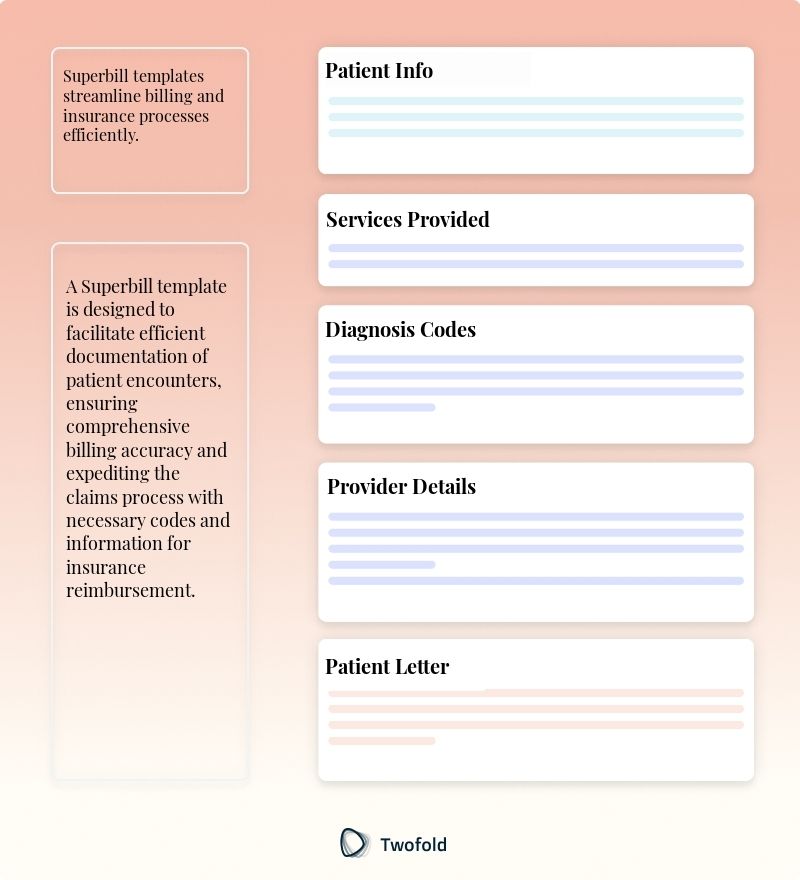
Superbill Template
Have you ever found yourself overwhelmed by the complexity of medical billing? If so, you're not alone. Many health professionals struggle with efficiently documenting and coding services. Luckily, the Superbill template is here to alleviate some of that stress. It’s a practical tool aimed at easing the medical billing process and ensuring accuracy. Let’s dive in and explore how you can make the most of this essential resource.
What Is a Superbill Template?
A Superbill is a comprehensive form used by healthcare providers to capture services provided during a patient visit. It serves as the primary data source for generating claims and ensures accurate billing and reimbursement.
The template simplifies billing processes by listing common procedures, diagnoses, and their corresponding codes. This organized approach reduces errors and speeds up billing cycles, making it a favorite for many medical offices.
Key Components of a Superbill
A Superbill template generally contains the following elements:
- Patient Information: Includes name, date of birth, patient ID, and contact details.
- Provider Details: Name, address, and National Provider Identifier (NPI) number.
- Date of Service: The specific date the healthcare services were provided.
- Procedure Codes: Common Procedure Terminology (CPT) or Healthcare Common Procedure Coding System (HCPCS) codes.
- Diagnosis Codes: International Classification of Diseases (ICD) codes that justify the services rendered.
- Additional Notes: Any supplementary information pertinent to the visit or billing.

How to Use a Superbill Template: Step-by-Step Process
- Begin by filling in patient demographics and insurance information.
- Select the appropriate procedure codes that correspond to the services provided.
- Choose diagnosis codes that accurately describe the patient's condition.
- Include the date of service and verify information for completeness.
- Submit the completed Superbill to your billing department or processing service.
Benefits of a Superbill
Benefit | Description |
|---|---|
Simplified Billing | Simplifies the process of documenting and billing patient visits, saving time for healthcare providers. |
Reduced Errors | By using pre-listed codes, the chances of documentation errors decrease significantly. |
Consistent Documentation | Ensures uniformity in billing practices, which aids in training new staff and maintaining compliance. |
Improved Reimbursement | Accurate coding increases the likelihood of correct reimbursements from insurance providers. |
Stakeholders in Superbill
The Superbill template affects several stakeholders in the medical industry, each playing a crucial role:
- Healthcare Providers: For doctors like Dr. Smith, a family physician, using a Superbill saves time during patient consultations, allowing them to focus more on care and less on paperwork.
- Billing Specialists: For Sarah, who manages billing for a busy clinic, the template drastically reduces time spent on claim submissions and rejections.
- Insurance Companies: Insurers rely on accurate Superbills to process claims efficiently, ensuring that they settle valid claims quickly without unnecessary back-and-forth.
- Patients: Patients benefit when claims are processed smoothly and accurately, reducing unexpected out-of-pocket expenses.
Example of a Superbill
Here’s a brief example of a typical Superbill used in a primary care setting, listing patient and provider details along with service and diagnosis codes.
Real-World Use Cases: Practical Impact of the Superbill Template
A Superbill is more than just a document—it impacts lives and workflows in meaningful ways:
- Pediatrics: For Dr. Lee, a pediatrician, a tailored Superbill ensures that coding for routine immunizations and check-ups is done correctly, helping to manage a busy schedule and high patient turnover.
- Specialized Medicine: In a specialized clinic, using a Superbill for physical therapy sessions allowed faster turnaround times for insurance approvals, letting patients like Emily access and complete their therapy regimens efficiently.
- Small-Mid Size Practice: A small clinic in the suburbs found that automating Superbills with their EHR system reduced the workload on their administrative staff, significantly lowering overhead costs while boosting service quality.
Conclusion
The Superbill template is an invaluable asset in medical billing, offering a structured approach to service documentation and insurance claims. Its use ensures accuracy, efficiency, and clarity in a process that can often be complex and error‑prone. By following best practices and keeping the Superbill updated, healthcare providers can concentrate on delivering patient care while streamlining their billing operations.
Disclaimer: This article is for informational purposes only and does not constitute legal or medical advice. Always consult professional guidelines and regulatory bodies for specific compliance requirements.

Dr. Danni Steimberg
Dr. Danni Steimberg is a pediatrician at Schneider Children’s Medical Center with extensive experience in patient care, medical education, and healthcare innovation. He earned his MD from Semmelweis University and has worked at Kaplan Medical Center and Sheba Medical Center.
Superbill notes bridge clinical work and reimbursement. This approach—honed through billing successes—ensures accuracy and keeps you audit‑ready.
- Match Each Service to a CPT & ICD Code: Pair services (e.g., 90837 for therapy) with the correct diagnosis codes (e.g., F33.1 for MDD) to lock in reimbursement.
- Provide Concise Justifications: Briefly state the clinical rationale (e.g., “session focused on depressive symptom management”) to prevent coding denials.
- Note Time & Complexity: For time-based or higher-level codes, specify duration and complexities—payers look for clear evidence of medical necessity.
Frequently Asked Questions
Reduce burnout,
improve patient care.
Join thousands of clinicians already using AI to become more efficient.

Blank SOAP Note Template
Discover practical Blank SOAP Note Template to enhance your documentation efficiency.

HIPAA Consent Form Template
Discover practical HIPAA Consent Form templates to enhance your documentation efficiency.

Evaluation Form Template
Discover practical Evaluation Form templates to enhance your documentation efficiency.


